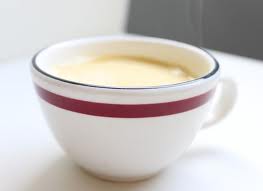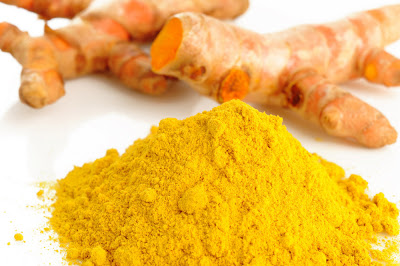 Do you have a jar of turmeric in the back of your spice cabinet, lonely and collecting dust? I do! Maybe you use turmeric to make a curry once in a blue moon or need it to add a natural yellow coloring to a sauce or condiment. But this spice, which is actually a plant and not an herb, is full of antioxidants, anti-inflammatories and there is evidence that there may be many health benefits to consuming turmeric.
Do you have a jar of turmeric in the back of your spice cabinet, lonely and collecting dust? I do! Maybe you use turmeric to make a curry once in a blue moon or need it to add a natural yellow coloring to a sauce or condiment. But this spice, which is actually a plant and not an herb, is full of antioxidants, anti-inflammatories and there is evidence that there may be many health benefits to consuming turmeric.
Dust it off and let’s use it!
 What exactly is turmeric? It’s part of the ginger family and considered a natural botanical compound. The roots are traditionally boiled, dried and ground into a powder. The plant grows to 5-6 feet tall in the tropical regions of Southern Asia with trumpet shaped, yellow flowers. Turmeric has been used in India for 4,000 years and is a major part of Ayurvedic medicine, which originated in India more than 3,000 years ago and remains one of the country’s traditional health care systems. Its concepts about health and disease promote the use of herbal compounds, special diets, and other unique health practices.
What exactly is turmeric? It’s part of the ginger family and considered a natural botanical compound. The roots are traditionally boiled, dried and ground into a powder. The plant grows to 5-6 feet tall in the tropical regions of Southern Asia with trumpet shaped, yellow flowers. Turmeric has been used in India for 4,000 years and is a major part of Ayurvedic medicine, which originated in India more than 3,000 years ago and remains one of the country’s traditional health care systems. Its concepts about health and disease promote the use of herbal compounds, special diets, and other unique health practices.
 The anti-inflammatory and antioxidant properties in turmeric are mainly attributed to its most active component, Curcumin. This compound is also what gives turmeric is yellow-orange color. An antioxidant helps to fight against free radicals in the body, which can damage DNA, cell membranes and even cause cells to die. Curcumin may even help prevent some of the damage that free radicals can cause. It also lowers the levels of two enzymes in the body that cause inflammation. Many diseases and illnesses may be positively affected by the Curcumin found in turmeric.
The anti-inflammatory and antioxidant properties in turmeric are mainly attributed to its most active component, Curcumin. This compound is also what gives turmeric is yellow-orange color. An antioxidant helps to fight against free radicals in the body, which can damage DNA, cell membranes and even cause cells to die. Curcumin may even help prevent some of the damage that free radicals can cause. It also lowers the levels of two enzymes in the body that cause inflammation. Many diseases and illnesses may be positively affected by the Curcumin found in turmeric.
1) Heart Disease: Because Curcumin helps stops platelets from clumping together and forming blood clots, turmeric may help blood clots from building up in the arteries. Early studies have suggested that turmeric may prevent atherosclerosis, which is caused by plaque buildup that can cause heart attacks or stroke.
2) Brain Health: A recent study suggests that Curcumin contains a brain boosting chemical could help slow the progressions of Alzheimer’s by helping hippocampal brain cells grow. Dr. Weil suggests that taking turmeric as a component in an anti-inflammatory diet, which can help prevent the risk of Alzheimer’s. In his website, he discusses the research that indicates that turmeric has been shown to prevent amyloid plaque formation in animals.
3) Cancer: It has been suggested by early research that Curcumin may help prevent or treat several types of cancers, including prostate, breast, skin and colon cancer. More research is needed to determine whether this is due to its strong antioxidant properties which protect cells from damage.
4) Indigestion: Studies have found that turmeric reduced symptoms of bloating and gas in people suffering from indigestion. It has been prescribed in Germany as an approved herb to treat digestive issues.
5) Osteoarthritis: Researchers believe that the anti-inflammatory properties in turmeric can help people with the pain and disability of arthritis. When combined with other herbs such as winter cherry, boswelia and zinc, less pain was reported.
6) Uveitis: In a study of people with chronic anterior uveitis, an inflammation of the eye’s iris, Curcumin was just as effective as prescribed medication of corticosteroids.
7) Bacterial and Viral Infections: Turmeric has been shown to kill bacteria and viruses but researchers need to do more studies of this to determine how effective it would be in people. Some apply turmeric to the skin for pain, ringworm, bruising, soreness inside the mouth and infected wounds.
8) Fat Metabolism and Weight Management: While studies are still preliminary, researchers at Tufts University believe turmeric may help prevent weight gain by blocking absorption of fat.
9) Anti-Depressant: In Chinese and Ayurvedic medicine, turmeric is used as an anti-depressant.
Buying Turmeric as a Dietary Supplement:
If you want to add supplements containing turmeric, Dr. Weil advises us to look for turmeric that has been prepared by the process of “supercritical extraction” which uses liquified carbon dioxide to extract the natural components of turmeric, rather than chemicals such as hexene, which can leave a residue. Also look for turmeric supplements that contain piperine, an alkaloid from black pepper which has been shown to improve turmeric’s bioavailability. Because bromeliad increases the absorption and anti-inflammatory effects of curcumin, it is often combined with turmeric products. Supplements that contain turmeric may interact with blood-thinning medications, drugs that reduce stomach acid and medications for diabetes.
 Dr. Sanjay Gupta’s Creamy Calming Turmeric Tea (veganized)
Dr. Sanjay Gupta’s Creamy Calming Turmeric Tea (veganized)
adapted from the recipe on Dr. Oz’s Episode with Sanjay Gupta
Ingredients
- 1 cup almond milk or coconut milk or combination of both
- 1/2 tsp turmeric
- 1 tsp cinnamon
- 1/2 tsp agave (to taste)
- 1/2 tsp ginger (either powdered or freshly cut from a 1/2 inch wide round slic eof ginger root, peeled and finely chopped)
Method
- 1. Warm the almond milk or coconut milk either in the microwave or gently on the stove.
- 2. In a coffee mug or tea cup, combine the turmeric, cinnamon, agave and ginger
- 3. Drizzle a teaspoon of the warmed almond or coconut milk into the mug with spices and mix until the liquid is smooth with no lumps.
- 4. Add the remaining milk and mix well.
- 5. You can leave the pieces of ginger in the tea or strain them out
 Broccoli with Turmeric and Tomatoes
Broccoli with Turmeric and Tomatoes
adapted from Food & Wine
Ingredients
- 2 Tbs coconut oil
- 2 onions, cut into long thin slices
- 3/4 tsp turmeric
- 1 head of broccoli, cut into florets and stems peeled and cut crosswise into 1/4 inch slices
- 15 oz container of grape or cherry tomatoes, each sliced in half
- 1/3 cup of water
- 3/4 tsp salt, to taste
Method
- 1. In a large frying pan, heat the coconut oil over medium heat.
- 2. Add the onions and cook, covered, stirring occasionally for 5 minutes
- 3. Uncover pan and continue to cook, stirring occasionally for about 5 more minutes until the onions are very soft but not crispy.
- 4. Stir in the turmeric to coat the onions.
- 5. Stir in the broccoli and tomatoes and water and salt and simmer.
- 6. Simmer uncovered until broccoli is tender, about 10 minutes.
 Turmeric-Spiced Mushrooms and Rice
Turmeric-Spiced Mushrooms and Rice
adapted from FitSugar
Ingredients
- 2 Tbs pine nuts
- 2 tsp extra-virgin olive oil
- 2 red onions, thinly sliced
- 3 tsp turmeric
- 1 lb. brown or baby portobello mushrooms, sliced
- 1 cup brown rice, rinsed
- 2 1/2 cups organic vegetable stock
- Juice of 1 lemon
- 2 handfuls of cilantro
- salt and pepper, to taste
Method
- 1. Preheat oven to 400 degrees.
- 2. Toast pine nuts in a dry frying pan, remove from heat and set aside
- 3. In a frying pan, heat the olive oil to medium heat. Add the onions and turmeric and fry for 3 minutes
- 4. Add mushrooms and fry for about 2-3 minutes
- 5. In an oven casserole, place the rice and vegetable stock.
- 6. Stir in the onion and mushroom mixture
- 7. Place in oven and cook for 45-55 minutes, check along the way to add more water if needed.
- 8. When rice is tender and the stock has been fully absorbed, stir in the toasted pine nuts, lemon juice, cilantro and salt and pepper.
Dr. Sanjay Gupta’s Creamy Turmeric Tea on Dr. Oz
Dr. Weil’s article called “Can a Spice Prevent Alzheimer’s?
University of Maryland Medical Center on Turmeric
Oregon State University Linus Pauling Institute
Efficacy and Safety of Curcumin in Major Depressive Disorder
As always, we do not profess to be doctors or diagnosticians but we like to share health information that could be beneficial to you. Please check with your doctor or healthcare professional before taking supplements that may interact with medications or adversely interfere with your doctor’s protocol, if you’re pregnant or have sensitive stomach issues.
xox Ellen













Turmeric is more absorbable if you add a dash of pepper 😉
Good to know! Thanks for the tip!
I bought the product today with just a little knowledge of its benefits, but thankyou Dr Sanjay Gupta’s for this great explanation.
According to Health Guru Andrew Weil, Turmeric the yellow colored spice offers several health benefits and protects the body from several diseases. To get the maximum benefits of turmeric it has to be taken along with pepper. He suggests using turmeric and pepper in cooking to make a healthy living. Regarding pepper, Green Peppercorns are receiving lot of attention these days because of its versatility and wide applications in foods. Because they are made in a very sophisticated manner as can be seen in the video below:
https://www.youtube.com/watch?v=egWySWXxOYY
Thanks for the recipes!
http://organicdailypost.com/turmeric-miracle-cure/
I have become a little curious about turmeric after reading about it
It seems like turmeric is definitely going mainstream!!